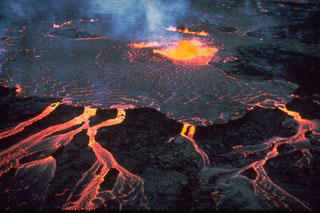Report on Kilauea (United States) — 5 December-11 December 2007
Smithsonian Institution / US Geological Survey
Weekly Volcanic Activity Report, 5 December-11 December 2007
Managing Editor: Sally Sennert.
Please cite this report as:
Global Volcanism Program, 2007. Report on Kilauea (United States) (Sennert, S, ed.). Weekly Volcanic Activity Report, 5 December-11 December 2007. Smithsonian Institution and US Geological Survey.
Kilauea
United States
19.421°N, 155.287°W; summit elev. 1222 m
All times are local (unless otherwise noted)
HVO reported that web camera views of fissure D from Kilauea's 21 July fissure eruption were mostly blocked by fog and fumes during 5-9 December. A brief view on 5 December revealed several overflows on the W side of Pond 1, a perched lava pond in the eruption channel formed by fissure D. A pilot report from an overflight on 6 December noted that all of the activity was close to fissure D and none of the SE Thanksgiving Eve breakout (TEB) flows traveled beyond 1.5 km. On 8 December, minor incandescence was observed in Pu'u 'O'o crater for the first time since 31 August, and was accompanied by a possible inflationary signal. Clear web camera views on 9 and 10 December revealed that the TEB shield continued to build vertically and was an estimated 15 m high. A few small earthquakes were located beneath the summit area and along the upper E rift zone and S-flank fault.
Geological Summary. Kilauea overlaps the E flank of the massive Mauna Loa shield volcano in the island of Hawaii. Eruptions are prominent in Polynesian legends; written documentation since 1820 records frequent summit and flank lava flow eruptions interspersed with periods of long-term lava lake activity at Halemaumau crater in the summit caldera until 1924. The 3 x 5 km caldera was formed in several stages about 1,500 years ago and during the 18th century; eruptions have also originated from the lengthy East and Southwest rift zones, which extend to the ocean in both directions. About 90% of the surface of the basaltic shield volcano is formed of lava flows less than about 1,100 years old; 70% of the surface is younger than 600 years. The long-term eruption from the East rift zone between 1983 and 2018 produced lava flows covering more than 100 km2, destroyed hundreds of houses, and added new coastline.
Source: US Geological Survey Hawaiian Volcano Observatory (HVO)

